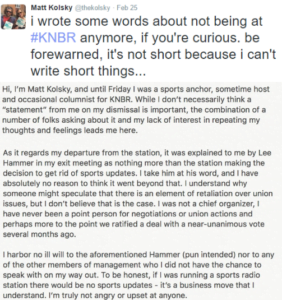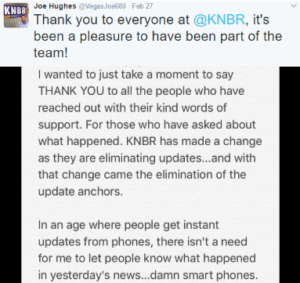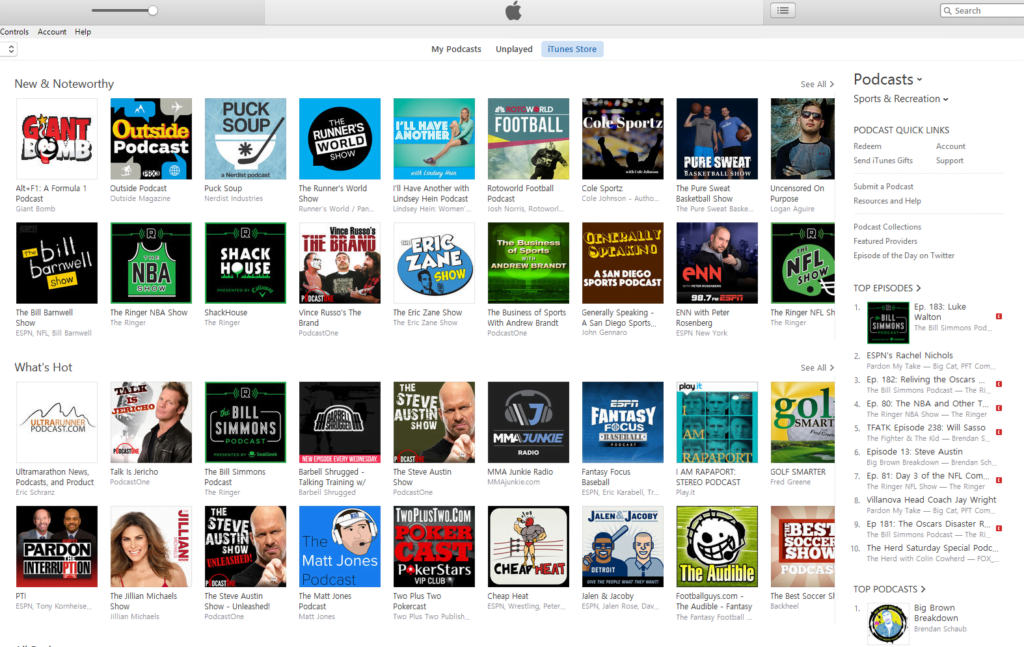I sat down recently with Damon Amendolara to tape an upcoming episode of the BSM Podcast and after our conversation he asked me “who out there today is revolutionizing sports radio”? I wanted to respond with a laundry list of sports stations who were doing unique things and staying ahead of the curve but I couldn’t.
And that’s not necessarily a bad thing. If a station has a system in place, and it’s working, and their fans are enjoying what they provide, then who am I to suggest that they should change just for the sake of being an industry leader?
But let’s be honest, not every brand in the business today is enjoying ratings and revenue success. Yet there’s a comfort factor that exists inside many buildings, which prevents stations from taking bold steps to improve programming in order to satisfy the growing demands and needs of the listening audience.
If you missed it, KNBR in San Francisco announced last week they were eliminating on-air sports updates. The move cost two update anchors employment at the radio station. While I never like to see anyone lose their position, the radio station made the right call, even if it wasn’t conventional or popular. Even the two terminated employees agreed with the station’s forward thinking.
For decades, sports radio stations have featured two to three sports updates per hour. WFAN in New York introduced the 20/20 sports flash which many CBS stations have adopted over the years, and brands which have aligned themselves with ESPN Radio, have taken a similar approach by using the branding of “SportsCenter Updates”.
In the past, the audience was at the mercy of relying on the radio station, newspaper and television for up to the minute information. We started our day reading the paper, utilized sports radio throughout the work day, and then turned to local sports television or SportsCenter at night to fill us in on what we didn’t know. These services were valuable because our access to information was limited and much slower.
But then along came the internet, which started making everything better, and in real time. All of a sudden, waiting until the next day to read a columnist’s opinion or reporter’s game story seemed ridiculous. As did waiting for the 10 o’clock news to watch a 3 minute sports report of information you learned about 8-12 hours earlier.
The worst of the group to adapt were newspapers. For decades the print business relied on selling advertising and charging people to read their work, but now thanks to the online space, readers were seeking the content online, and for free, causing the print industry to lose a ton of revenue it was dependent on.
The shift also placed more pressure on writers who were now tasked with writing their stories, adding blogs, chatting with readers, and in some cases, creating video. The same began to take place in television where some reporters and on-air commentators were heading into the field with cameras and being expected to edit their own work.
Next came the explosion of social media. Facebook and Twitter took off, and soon we’d have conversations with family and friends, while increasing our connections and relationships with brands and their key people. As we gained more knowledge of the social experience, we started passing along content which we found interesting, helping brands reach more people with their content in the process.
This forced reporters, columnists and personalities to open themselves up even more. Soon they were reporting information on social platforms, before even doing so on their own airwaves or websites. Once again, the audience demanded instant information, and if sports media members weren’t providing it, they’d find others who could.
So that brings us to the present state of sports radio and its connection to on-air updates.
Many have mixed opinions on the impact and benefit of these reports, so let me present both sides of the debate so you can process the information and arrive at your own conclusion regarding their future value.
First, why should they be kept? Those in favor of keeping them on the air will tell you that they provide a few positives. Here are six examples.
- They air 2-3x per hour, which means sponsors have the opportunity to attach their :05-:10 tag lines to them. Considering that during the span of a 13-hour broadcast day, a radio station is going to provide 26-39 of these reports, which adds up to 130-185 per week, that’s a lot of frequency for sponsors to latch onto.
- The updates help inform sports fans of the most important stories of the day in a short amount of time and if the talk show host isn’t discussing a particular story, the listener can still find out about it.
- They are positioned at set times, which allows the audience to develop a routine with the radio station. The listener knows that regardless of what’s happening on a talk show, they can rely on the brand to inform them at specific times.
- They add an extra voice to the daily conversation, and help break up the talk show. The extra voice in the room also at times becomes a contributor to the talk show, leading to an increase in entertainment value.
- By having the updates in place, the audience doesn’t have to rely on their phones while driving, allowing them to stay informed without risking the potential of an accident.
- They serve as a great marketing tool for promoting the radio station’s on-air content, often using audio from other parts of the broadcast day which the audience may not have heard, helping to drive digital downloads or additional listening to other shows.
All of the reasons that I mentioned above are valid and why some programmers and market managers are reluctant to change course. But now let’s look at the other side of the argument.
- Although the radio station presents 26-39 updates per day and 130-195 per week, and they may be available for sponsorship, most brands use them as value added for advertisers, which means there isn’t a ton of revenue being generated specifically for the reports. Some will argue that the station wouldn’t land the advertisers dollars it does without added value sponsorship’s, but the client cares most about the frequency of their message being communicated on the air. Whether they’re attached to a time check, sports update, on-air reset or show feature, they’re flexible.
- The update may serve up sports information but most of it is material which the the majority of the audience is already aware of. Sports fans are constantly seeking out information and opinion and feeding them material which lacks urgency, suspense and value gives them reason to change the dial.
- Routine is certainly a benefit IF the audience values the content being presented. If not, you’ve created a position on the radio station which tells them the exact times of when to tune out the radio station.
- Adding extra voices to a talk show helps keep it interesting, but does that mean the station needs to feature 8-12 reports during the show just to include the anchor in 5-10 minutes of conversation? Is that really a wise way to use a station’s resources, if this is the best value that comes from the position?
- Yes it’s true, keeping the phone out of the listener’s hands when they’re in their car is a great idea. Nobody wants to see loyal listeners die or end up in a hospital, but this is assuming the driver in each car is going to act responsible, which we all know, they won’t. There’s also the reality that listening to shows by phone has increased and will continue to do so, and if a station is fielding 13 hours of updates when most people spend 1-2 hours per day in their cars, then the question is, why is that a smart strategy?
- I love the idea of marketing the radio station’s content in updates but how many anchors actually do that? Most use the time to look ahead to what’s coming up each night or they use the time to share stories they discovered on other sports websites. Scan around the country and aside from hearing a different voice, cadence and energy, much of the content is similar. If it’s not unique, and not redirecting the audience back to the station’s website, talk shows or social media pages, then it’s not taking advantage of the on-air marketing opportunity.
When I raise this issue, I do so with a big picture view of the industry in mind. I’m not one of these people who thinks we should change things just for the sake of change. But I also don’t think that you fix the problem by just having your host read reports or changing the name from your updates. Those are the dumb things that we do as an industry sometimes that just miss the point. It’s not about name changes or who reads the script, it’s about the value of the actual update/content.
To move a brand forward I believe you need to look at things from the inside out. Each station and company has to decide what matters most and direct their resources to the areas where they can make the biggest difference. If your station has a bottomless budget and isn’t under pressure to satisfy the bottom line, then feel free to ignore this entire piece because clearly your brand is in such a unique position that it can do whatever it pleases.
But from where I sit, I see the world of digital and social media exploding and being critical to the future of our brands. It’s already grown leaps and bounds over the past decade and it’s only going to increase as we move forward. Yet when I look at the creativity, execution, originality and engagement of sports radio brands in these spaces it’s very underwhelming.
Have you looked at the iTunes charts to see which shows perform best? Aside from a few national programs which have the scale of hundreds of markets pushing their content, the majority of top rated programs come from shows which aren’t on radio stations. Whether it’s Bill Simmons, Pardon My Take, Richard Deitsch, Adrian Wojnarowski’s The Vertical or numerous wrestling podcasts which have built up dedicated audiences, sports fans who turn to the most powerful digital platform to hear sports audio can’t find sports radio shows here because they don’t stand out.
Keep in mind, sports stations have a megaphone to use to promote their audio offerings. Many of these other digital offerings don’t.
But let’s move iTunes to the side for a second. Have you taken a look at the websites of most of the nation’s sports radio brands? Many operate with the same shell, pull information from the Associated Press or other news providers, and when you turn to their audio section, you find 3-4 hours of audio per show (minus the commercials) and minimal original content of value.
A big reason why digital audio is attractive is because it gives the listener something back that they value tremendously – time! They want to enjoy the show/host, but do so in shorter fashion. Yet most sports stations take the same exact on-air product, throw it on the web, and call it a day.
Except that is not giving the audience what they want. The best 60 minutes of your content gives them reason to click and listen. A GREAT 15-30 minutes of your best stuff makes them even more likely to download your material. Heck, even websites like Clammr allow brands to showcase up to 24 seconds of audio, which can be used as a short teaser to give the listener incentive to listen to the podcast. Sadly not many take advantage of these opportunities.
But that’s only the audio portion of this story. Now let’s examine the social media picture. After all, it is where the audience begins, continues, and ends their day, and a space you can’t afford to not be an expert in. I’ll let you know that I spent 2 days last week evaluating a ton of sports radio stations across the country on social media and I’ll be sharing my findings in a future column.
Take a minute and locate your favorite sports radio station on Facebook and Twitter. Now go thru their last 10 posts, and tell me how much unique content you find on each platform. Then look at how often the station redirects the audience back to the airwaves, its website, its podcasts or another area where the brand can benefit.
You’re going to find a lot of holes, but that’s not even the worst of our sins.
Let’s now examine how often the radio station engages in conversation with its audience on social media. Go thru those same 10 posts, and tell me how many times you’ve seen the radio station respond or acknowledge any comments left behind by the brand’s most important asset, its listeners. It rarely happens.
When I see this occur, it reinforces a few of my opinions.
First, it speaks to a lack of internal focus on the digital and social experience. People just post content and assume the audience will see it. They don’t always think about what they’re posting, how they’re saying it, what times they’re posting it or if it involves a strategic element to redirect the listener to another part of the radio station’s business.
Secondly, it shows a lack of manpower in most buildings. Stations tack on the responsibility of social and digital media execution to their employees, but because they don’t understand the space or how to be experts in it, and don’t sell a ton of advertising on it, they just assume it’s an extra thing the brand must do.
The third thing I’m reminded of is that unless things change, a listener who values their time and making connections, is better served NOT following the radio station’s social media accounts. Instead they should invest their time in the hosts. Why? They’re more likely to earn a response on-air or on social media from the talent, plus they’ll get to know them better. They can also still learn about what’s taking place on the air from the host, and if the brand is only interested in a one way relationship, then what’s the return on time spent supporting the brand for the audience?
Folks, it’s called SOCIAL media for a reason. It’s not “push content at you and ignore your existence” media. If an audience litters your social media pages with hundreds to thousands of responses per day, and you never take a minute to hit the like button or respond to their questions, suggestions, comments or complaints or provide any special benefits or unique experiences that are only available to your followers, then there’s little reason for them to actively supporting your pages.
So now let’s bring this full circle.
The format lacks original podcasts. Brands don’t promote short-clips of their station’s best content to entice the audience to download their programming. They’re not condensing a 4 hour show into the best 30-60 minutes to make it more appealing to the listener. We’re also not engaged or strategically exploring ways to increase brand loyalty with the audience.
Yet here we sit, having a debate about the value of sports updates, an area of the business which many would agree is not critical to the success of our stations. Our reluctance to change what we do and focus on the areas of our business that matter is no different than the print industry’s ignorance of thinking their customers would continue paying to read their stories online. At some point you have to make difficult decisions or risk becoming expendable by the audience.
I’m not saying there aren’t some excellent anchors on the air in markets across the country. I’m also not suggesting that brands like WFAN or ESPN Radio should abandon utilizing sports updates because they’ve built a certain expectation with their products that the audience does tune to them for. There are always exceptions.
But that’s not the case with most brands.
It’s not the anchor’s fault that the audience has gained access to information faster on social and digital media. Or that the listener has been treated to thousands of audio options and now utilizes the station they love for a shorter amount of time. But if that’s what people are doing, and these are the platforms where they are spending time, and it’s where advertisers are shifting their dollars (they are), then your brand has to make a commitment to being great in the space or it will come back to haunt you.
I mentioned this on my last episode of the BSM Podcast, those who are in anchor positions, should be thinking of the ways they can reinvent themselves and offer value beyond two two-minute reports per hour. Can you deliver video commentaries? Write columns? Report on local teams and break news? Host shows? If you have knowledge of how to help the brand master its digital and social media experience that helps too.
Sports updates have lost their appeal because the content isn’t special, the information is available elsewhere, and it can be consumed in a much shorter time. The phone and computer have become great weapons for the audience, which makes it harder than ever to win the battle for their time.
The audience craves our talk shows and personalities. This is our entry point to their hearts and minds. They don’t get interrupted 2-3x per hour when watching a movie, sitcom or sports television show, and we can’t continue to place speed bumps in front of them during our shows and think it’s going to better serve us in the battle to grow ratings and brand loyalty. That makes zero sense.
Whether we like it or not, the audience’s demands have increased. We’re now operating in a sea of audio after decades of being the dominant fish in the pond. Attention spans are shortening, listening occasions are less frequent, and the appetite for social and digital media continues to rise like a phoenix.
The same hurdles exist on television where SportsCenter now finds itself having to reinvent its approach after being the go to source for the entire sports universe. As a result, ESPN has been losing money and viewers, and finds itself in the most vulnerable spot it’s ever been in as a business.
This is the reality of the world today, and when it comes to providing a strong digital and social experience, radio is standing in the batter’s box with a toothpick trying to hit an Aroldis Chapman fastball over the fence. It may not be comfortable, but to stay ahead in this competitive environment, each brand, manager, anchor and company has to evaluate the areas of their brand that matter most, and figure out how to shift resources from areas that are less important to others which provide a significant benefit.
KNBR recognized it needed to change for the betterment of its future, and did so by eliminating a convenient part of their product, but not a necessary one, sports updates. I can only hope that you’re willing to make the same gutsy decision down the line, because it’s not a question of IF it will be necessary, it’s a question of WHEN!

Jason Barrett is the President and Founder of Barrett Media since the company was created in September 2015. Prior to its arrival, JB served as a sports radio programmer, launching brands such as 95.7 The Game in San Francisco, and 101 ESPN in St. Louis. He also spent time programming SportsTalk 950 in Philadelphia, 590 The Fan KFNS in St. Louis, and ESPN 1340/1390 in Poughkeepsie, NY. Jason also worked on-air and behind the scenes in local radio at 101.5 WPDH, WTBQ 1110AM, and WPYX 106.5. He also spent two years on the national stage, producing radio shows for ESPN Radio in Bristol, CT. Among them included the Dan Patrick Show, and GameNight.
You can find JB on Twitter @SportsRadioPD. He’s also reachable by email at Jason@BarrettMedia.com.










